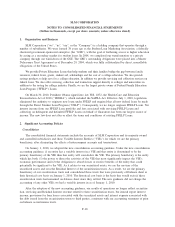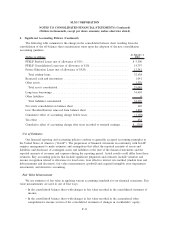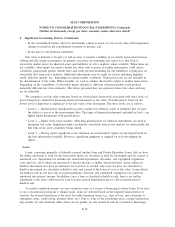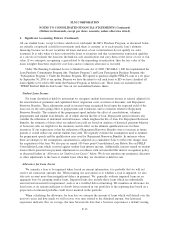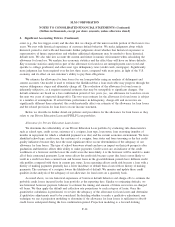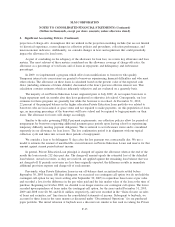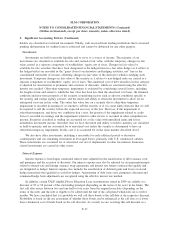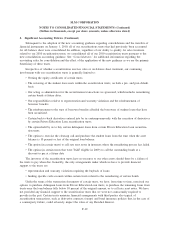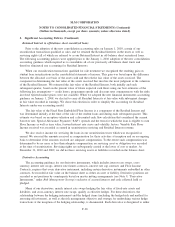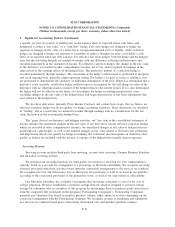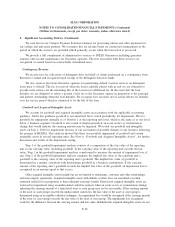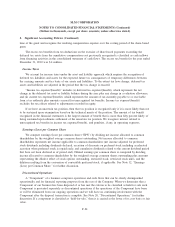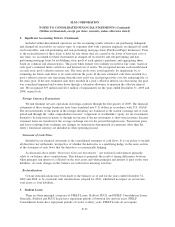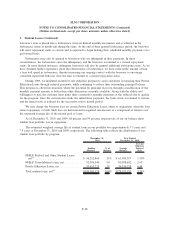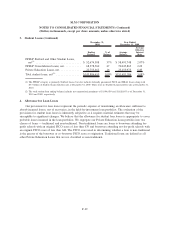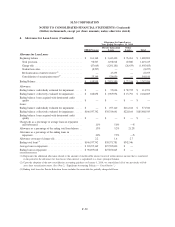Sallie Mae 2010 Annual Report Download - page 123
Download and view the complete annual report
Please find page 123 of the 2010 Sallie Mae annual report below. You can navigate through the pages in the report by either clicking on the pages listed below, or by using the keyword search tool below to find specific information within the annual report.2. Significant Accounting Policies (Continued)
Retained Interest in off-balance sheet securitized loans
Prior to the adoption of the new consolidation accounting rules on January 1, 2010, certain of our
securitization transactions qualified as sales and we retained the Residual Interests in the trusts as well as
servicing rights (all of which are referred to as our Retained Interest in off-balance sheet securitized loans.
The following accounting policies were applied prior to the January 1, 2010 adoption of the new consolidation
accounting guidance which required us to consolidate all of our previously off-balance sheet trusts and
therefore eliminated any accounting for Residual Interests.
When our securitization transactions qualified for sale treatment we recognized the resulting gain on
student loan securitizations in the consolidated statements of income. This gain was based upon the difference
between the allocated cost basis of the assets sold and the relative fair value of the assets received. The
component in determining the fair value of the assets received that involves the most judgment is the valuation
of the Residual Interest. We estimated the fair value of the Residual Interest, both initially and each
subsequent quarter, based on the present value of future expected cash flows using our best estimates of the
following key assumptions — credit losses, prepayment speeds and discount rates commensurate with the risks
involved. Quoted market prices were not available. When we adopted the new financial instruments accounting
guidance on January 1, 2008, we elected to carry all Residual Interests at fair value with subsequent changes
in fair value recorded in earnings. We chose this election in order to simplify the accounting for Residual
Interests under one accounting model.
The fair value of the Fixed Rate Embedded Floor Income is a component of the Residual Interest and
was determined initially at the time of the sale of the student loans and during each subsequent quarter. This
estimate was based on an option valuation and a discounted cash flow calculation that considered the current
borrower rate, Special Allowance Payment (“SAP”) spreads and the term for which the loan is eligible to earn
Floor Income as well as time value, forward interest rate curve and volatility factors. Variable Rate Floor
Income received was recorded as earned in securitization servicing and Residual Interest revenue.
We also receive income for servicing the loans in our securitization trusts which was recognized as
earned. We assessed the amounts received as compensation for these activities at inception and on an ongoing
basis to determine if the amounts received are adequate compensation. To the extent such compensation was
determined to be no more or less than adequate compensation, no servicing asset or obligation was recorded
at the time of securitization. Servicing rights are subsequently carried at the lower of cost or market. At
December 31, 2010 and 2009, we did not have servicing assets or liabilities recorded on the balance sheet.
Derivative Accounting
The accounting guidance for our derivative instruments, which includes interest rate swaps, cross-
currency interest rate swaps, interest rate futures contracts, interest rate cap contracts and Floor Income
Contracts, requires that every derivative instrument, including certain derivative instruments embedded in other
contracts, be recorded at fair value on the balance sheet as either an asset or liability. Derivative positions are
recorded as net positions by counterparty based on master netting arrangements (see Note 9, “Derivative
Instruments,” under Risk Management Strategy) exclusive of accrued interest and cash collateral held or
pledged.
Many of our derivatives, mainly interest rate swaps hedging the fair value of fixed-rate assets and
liabilities, and cross-currency interest rate swaps, qualify as effective hedges. For these derivatives, the
relationship between the hedging instrument and the hedged items (including the hedged risk and method for
assessing effectiveness), as well as the risk management objective and strategy for undertaking various hedge
transactions at the inception of the hedging relationship, is documented. Each derivative is designated to either
F-20
SLM CORPORATION
NOTES TO CONSOLIDATED FINANCIAL STATEMENTS (Continued)
(Dollars in thousands, except per share amounts, unless otherwise stated)


